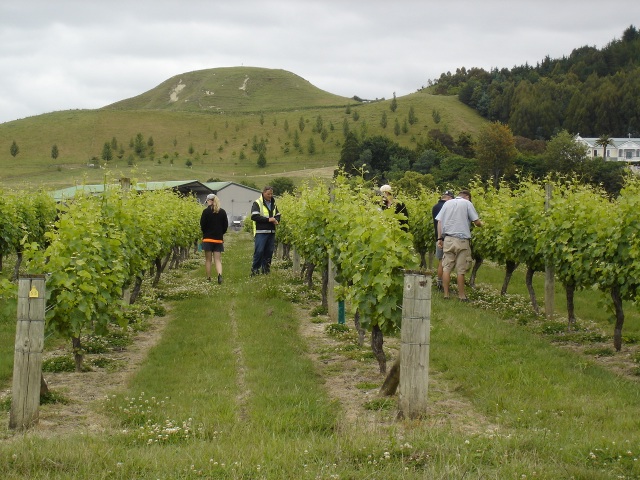On Bart’s arrival on the 7th of December for his second advisory visit to the vineyard, we discussed with Peter Holley (CEO, Mission Estate) the project to date and how it was progressing.
At this stage in the growing season the Pinot Gris, Chardonnay have completed flowering and Sauvignon Blanc is at the tail end of flowering. All blocks have been shoot thinned with doubles, unders and heads cleaned out. The collard leaf blower has also been through the Pinot Gris and Chardonnay to open up the bunch zone and to remove trash from within the bunch.
The organically run blocks have had sulphur (3kg/ha), copper (1kg/ha), protector (0.5%) and seaweed (2 l/ha) as foliar sprays through the season. These have been put on at 500 l/ha. Botryzen was used at 80% flowering for botrytis control.
In the conventional blocks we have used Kumulus (3kg/ha) and diathane (2kg/ha) as our foliar program leading into flowering with the use of 2 x applauds pre flowering for mealy bug control. At 80% flowering we used systhane (125ml/ha and switch 800g/ha) for powdery mildew and botrytis control.
At this stage in the project there seems to be no differences between any of the growing regimes in terms of canopy growth, timing of flowering or bunch numbers or pest and disease.
In terms of weed control we have run through our Pinot Gris block with the double sided Clemens which has done a fantastic job at clearing out the late spring weed growth. However it is important to note that care does need to be taken by staff when tucking in cultivated blocks as soil is turned over and it can be very easy to trip on and cause injury to staff.
We’ve noticed a few damaged plants from cultivation as well. I think that this is the reality when cultivating undervine so it needs to be built into operational repairs and maintenance budgets if growing under an organic regime.
In terms of canopy management, the Sauvignon Blanc blocks will be sheep leaf plucked, so hopefully these blocks won’t require any further cultivation. The Pinot Gris and Chardonnay will be machine leaf plucked and will probably require at least another mechanical cultivation. Some bunch thinning may also be required in Pinot Gris; this will be dependent upon bunch numbers and bunch size.
Over flowering the temperatures have been warm which should ensure a reasonable fruit set. There was however a significant wet weather event during the flowering period so it will be interesting to see if there are any latent effects of this at harvest when comparing the two regimes.
There has been a small amount of powdery mildew found on some leaves in the Pinot Gris and Sauvignon Blanc in both the conventional and organic blocks. We will monitor this closely as the season progresses, especially leading into the Christmas period.
We are keeping a full economic analysis of the project to date and at this stage in the season the organic farming regime is significantly cheaper in terms of running costs per hectare. The extra cost of the conventional regime is mostly due to extra sprays for mealy bug under the industry standard conventional spray program which we have been using, whereas the organic blocks are being monitored for mealy bug before taking any action. It will be interesting to see how this pans out for the rest of the season. Watch this space……..



There is always the chance of damage to plants whatever the machinery moving through the vineyard. Undervine cultivation by it’s very nature is extremely hazardous to all plants. The only way to minimise damage is to ‘stake’ young plants. All conventional cultivators rely on sensing the plants to move the implement away. However, if your plant is less than 3 or 4 years old the likely hood is that the sensor won’t ‘sense’ the plant and the plant will be cut or tilled out of the soil. The damage at The Mission Church Rd block was caused by the Clemens under-cutters to younger plants. The initial ‘earthing up’ does not rely on sensors and is therefore a lower risk.
Moving to organic growing does mean a change of attitude is required and planning for those little annoyances is paramount when keeping the end goal is sight. You have to think about ‘tripping possibilities when contractors are working in the vineyard, staking young plants, moving irrigation pipes higher and of course the new visual aspect of your vineyard – it’s not going to look like an English rose garden anymore! But, if you want my opinion as a grower, the rough unkempt look is far better than the sterile anaerobic surface left by herbicides.